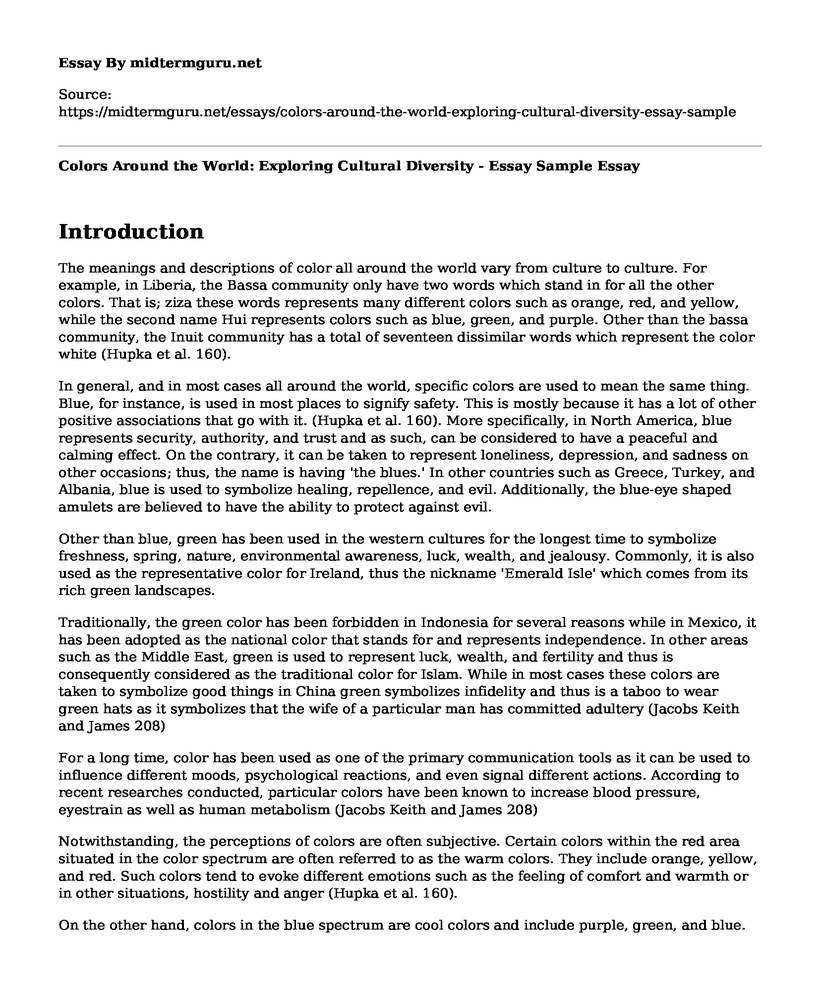Introduction
The meanings and descriptions of color all around the world vary from culture to culture. For example, in Liberia, the Bassa community only have two words which stand in for all the other colors. That is; ziza these words represents many different colors such as orange, red, and yellow, while the second name Hui represents colors such as blue, green, and purple. Other than the bassa community, the Inuit community has a total of seventeen dissimilar words which represent the color white (Hupka et al. 160).
In general, and in most cases all around the world, specific colors are used to mean the same thing. Blue, for instance, is used in most places to signify safety. This is mostly because it has a lot of other positive associations that go with it. (Hupka et al. 160). More specifically, in North America, blue represents security, authority, and trust and as such, can be considered to have a peaceful and calming effect. On the contrary, it can be taken to represent loneliness, depression, and sadness on other occasions; thus, the name is having 'the blues.' In other countries such as Greece, Turkey, and Albania, blue is used to symbolize healing, repellence, and evil. Additionally, the blue-eye shaped amulets are believed to have the ability to protect against evil.
Other than blue, green has been used in the western cultures for the longest time to symbolize freshness, spring, nature, environmental awareness, luck, wealth, and jealousy. Commonly, it is also used as the representative color for Ireland, thus the nickname 'Emerald Isle' which comes from its rich green landscapes.
Traditionally, the green color has been forbidden in Indonesia for several reasons while in Mexico, it has been adopted as the national color that stands for and represents independence. In other areas such as the Middle East, green is used to represent luck, wealth, and fertility and thus is consequently considered as the traditional color for Islam. While in most cases these colors are taken to symbolize good things in China green symbolizes infidelity and thus is a taboo to wear green hats as it symbolizes that the wife of a particular man has committed adultery (Jacobs Keith and James 208)
For a long time, color has been used as one of the primary communication tools as it can be used to influence different moods, psychological reactions, and even signal different actions. According to recent researches conducted, particular colors have been known to increase blood pressure, eyestrain as well as human metabolism (Jacobs Keith and James 208)
Notwithstanding, the perceptions of colors are often subjective. Certain colors within the red area situated in the color spectrum are often referred to as the warm colors. They include orange, yellow, and red. Such colors tend to evoke different emotions such as the feeling of comfort and warmth or in other situations, hostility and anger (Hupka et al. 160).
On the other hand, colors in the blue spectrum are cool colors and include purple, green, and blue. They are known to have a calming effect and often bring the mind to feelings of indifference or sadness.
Isaac Newton successfully established the visible spectrum, that is; the colors we see in a rainbow, and thus created the leeway for others to explore different colors in a very specific manner. These discoveries were able to open new doors and breakthroughs in fields such as chemistry, perception, and physics.
Newton discovery of the ROYGBIV colors greatly contributed to the modern technologies we are familiar with and use today. These colors collectively for the visible part of the visible spectrum, which is a narrow section within the electromagnetic spectrum that can be seen by the naked human eye.
Conclusion
In conclusion, different colors have different meanings across different cultures and thus should be appreciated as they are. Additionally, different colors have a major influence on our psychological behaviors and most often than not elicit different emotions and behaviors among different people
Work Cited
Hupka, Ralph B., et al. "The colors of anger, envy, fear, and jealousy: A cross-cultural study." Journal of cross-cultural psychology 28.2 (1997): 156-171.
Jacobs, Keith W., and James F. Suess. "Effects of four psychological primary colors on anxiety state." Perceptual and motor skills 41.1 (1975): 207-210.
Cite this page
Colors Around the World: Exploring Cultural Diversity - Essay Sample. (2023, Jan 23). Retrieved from https://midtermguru.com/essays/colors-around-the-world-exploring-cultural-diversity-essay-sample
If you are the original author of this essay and no longer wish to have it published on the midtermguru.com website, please click below to request its removal:
- Paper Example on SBIRT: Screening, Brief Intervention, and Referral to Treatment
- Analysis of Gender Gap Pay Using Conflict Theory - Essay Sample
- The Use of Telemedicine To Provide or Enhance Substance Abuse Services in Underserved Areas - Essay Sample
- Protecting Children: Rise of Child Abuse Despite Efforts to Combat It - Essay Sample
- Pedophilia & Cognitive Impairment: Examining Neurodevelopmental Correlates - Essay Sample
- LGBT Youth Suicide: A Growing Crisis - Essay Sample
- Immigration Policy & National Security: A Challenge to Existing Thinking - Essay Sample







